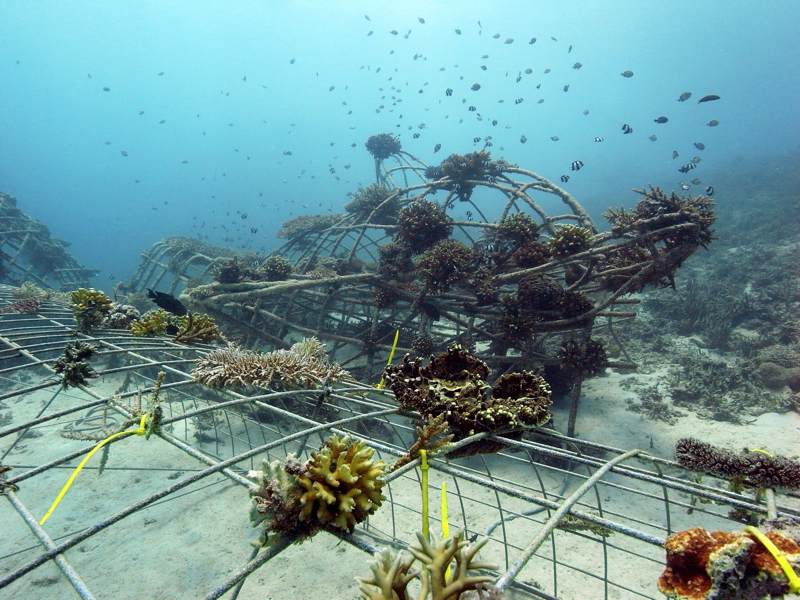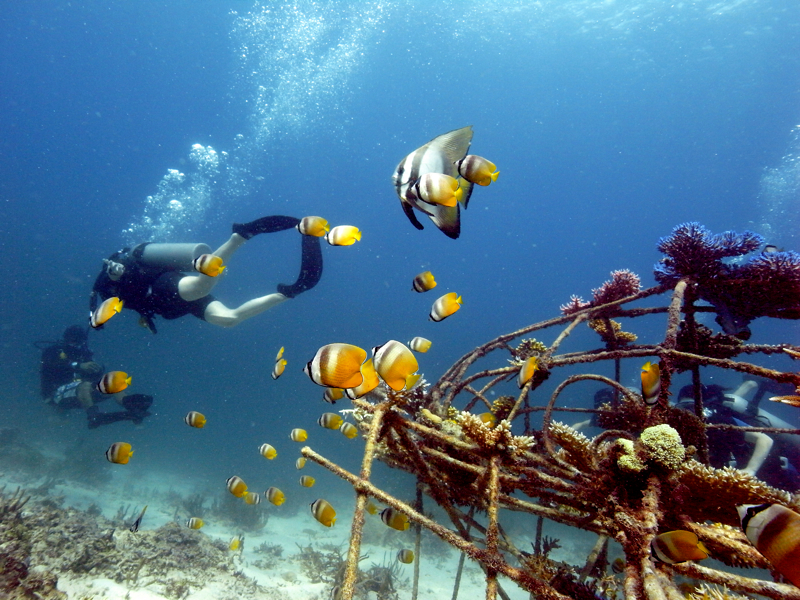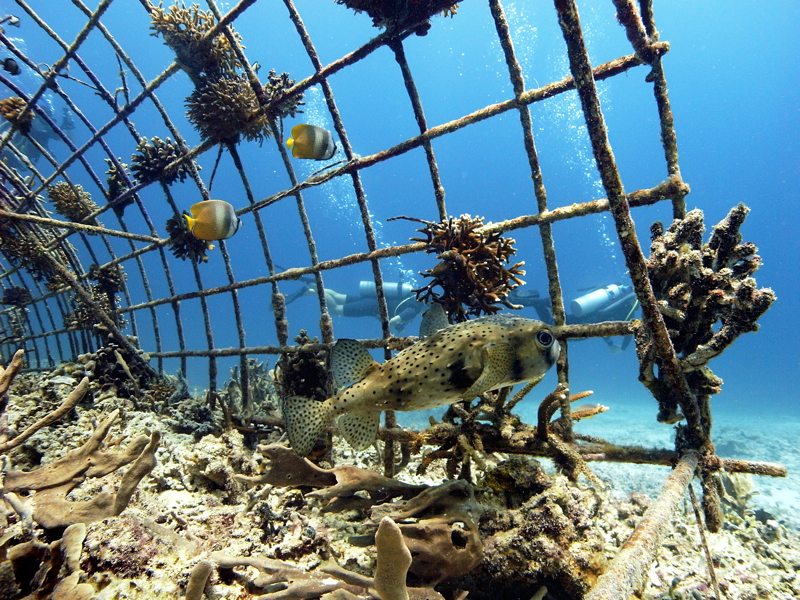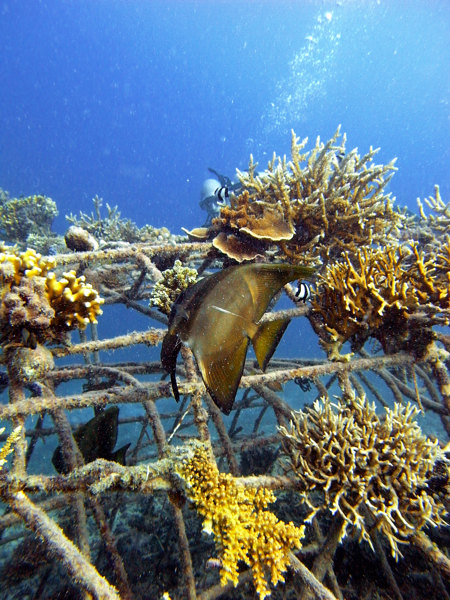“I don’t believe we have found a solution for stopping the detrimental impact on the corals, but what we have managed to achieve with BioRock is the preservation of the marine biodiversity.”
“Gear check, regulator, mask, open tank,” shouts Delphine, as we shuffle ourselves backwards to let our tanks hang over the ledge of the pump boat. The nose of the boat kisses the lip of a wave, jolting the horizon ahead at a 45 degree angle. It does not stop Delphine from throwing herself into the choppy waters. We all follow.
By the time I resurface, my mask is vertically swept across my face and my regulator is spurring out of control. The currents are pulling us like threatening gusts of wind as we begin descent.
I expect to be greeted by rainbows of brilliant reds, blues and greens. Unfortunately, all that was left was a graveyard of corals bleached deathly white, the rest shattered to pieces from explosive fishing methods or poisoned by cyanide.
Delphine Robbe is a French eco-warrior who moved to Gili Trawangan, a small island located between Bali and Lombok, Indonesia, in 2004. She is the driving force behind the Gili Eco Trust, an NGO set out to protect the local environment. In 2005, she introduced BioRock to the Gili islands with the help of Foued Kaddachi, who reinstated an underwater metropolis that has innumerable connections with surrounding ecosystems.
What is BioRock?
The BioRock technology, invented by Tom Goreau and Professor Wolf Hilbertz, uses a low electrical voltage to create a electrical field around a rebar metal frame, a process also known as “electrolysis”. This propagates the steel structure to grow solid limestone minerals, which provide corals with a good substrate to grow on.
The corals are then collected and mounted onto the structure to let their limestone skeletons merge with the rebar metal, and the metal eventually disintegrates.
This mimics the natural process of reef formations, when colonies of tropical marine plants and animals with limestone skeletons rise atop earlier generations.
Studies show the electrical current in BioRock helps coral reefs grow faster and remain healthier. It provides breakwater material because it grows stronger with age and repairs itself if damaged by heavy waves.
The 130 structures submerged beneath the Gili waters make Indonesia the most advanced BioRock eden in the world.
The collective structures eventually grow strong enough to act as a buffer against heavy seas – and have already allowed some beaches in one of the Gili islands to reclaim up to 10m of sand back.

Structures vary in shape to provide species with different nooks and niches to hide from predators. [Image credit: Foued Kaddachi]
“I do not believe we have found a solution for stopping the detrimental impact on the corals, but what we have managed to achieve with BioRock is the preservation of the marine biodiversity.
“By installing BioRock in as many locations as possible, we have saved some coral reefs.”
A peak beneath the water
From the surface I can make out shapes varying from sharks to stingrays, providing each reef with nooks and niches which promote biodiversity for different species. The rebar metal has turned white, as limestone minerals, which are naturally dissolved in seawater, grow over the surface.
Complex tangles of coral polyps continue to grow from their limestone foundation, some already hosting a multi-hued school of colourful fish above it.
A couple of the structures have already become home to an array of soft, hard, tunicates, bivalves in just over a year.
A small flock of parrotfish, excreting white sand, rush over our heads. Their droppings contribute to the production of tropical sand that make up pristine white beaches. This partnership plays a role virtually everywhere you see on the reef. By the end of the dive, we found ourselves feeling like we were joining the ecosystem.
BioRock at Gili Eco Trust
The Gili Eco Trust works closely with the dive shops, using their expertise to maintain buoys, clean junk off the reef, help with research projects, educate the public and reposition coral branches which have been knocked off their colony.
“When a business wants to contribute to the BioRock project, they will pay a fee to get the technology installed at their convenience,” explained Delphine. “Thereafter, it is up to the Gili Eco Trust to maintain and expand each BioRock site with the eco tax money.”
The dive shops in Gili Trawangan have added an additional tax fee to each dive, which goes towards funding BioRock and continuing to push for eco-friendly tourism.
Sian Williams, Co-ordinator of Gili Eco Trust, said:
“Because of the power supply that we feed our BioRocks, they do need a lot more maintenance than other types of reef restoration.”
[Photo credit: Foued Kaddachi]
BioRock to the rescue during El Nino
The El Nino current has claimed up to 50% of Indonesia’s reefs in the past 30 to 40 years. During the 1997-1998 El Nino event, widespread and severe coral reef bleaching claimed 16% of the world’s coral reefs in just under 12 months.
“The 1998 and 2015 bleaching events were by far the most damaging,” reflected Delphine.
Corals on BioRock see 1600% to 5000% higher survival rate than corals on nearby reefs after severe bleaching events. Delphine reconfirmed that BioRock is what saved most of the reefs in the Gili islands after this year’s El Nino event.
“We monitored the corals during the bleaching event to find that those on the BioRock were the ones which survived.”
So why don’t more countries use the BioRock? Although the technology has been introduced in more than 20 countries, it is patented, which means that it remains inaccessible to others.
Delphine continued: “BioRock is a slow process. Many people have tried to replicate the technology but were unsuccessful, entailing bad promotion for the technology.”




